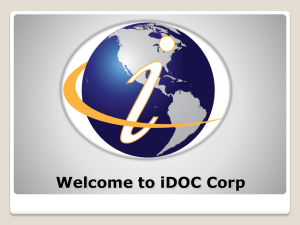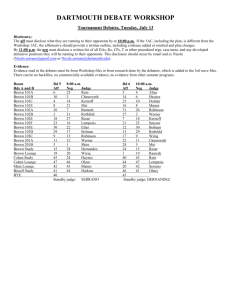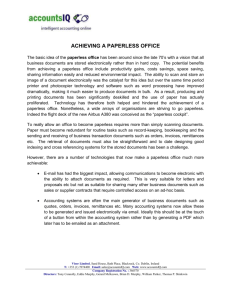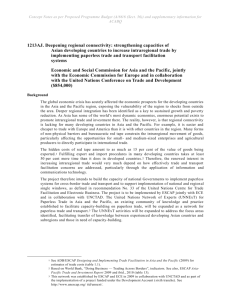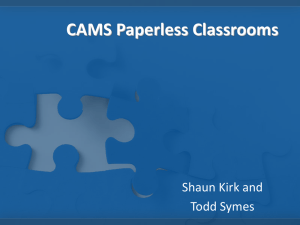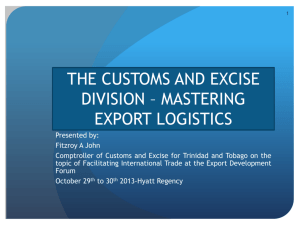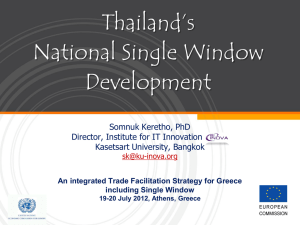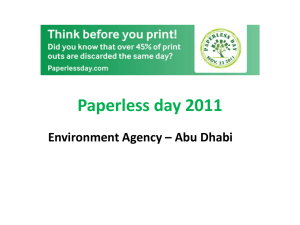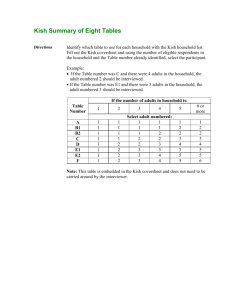ECO-ESCAP Joint Trade Facilitation Forum on Paperless
advertisement
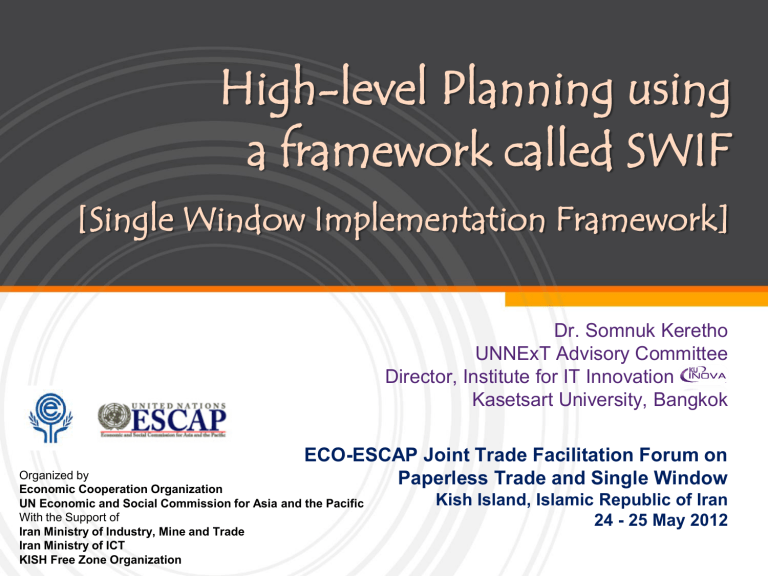
High-level Planning using a framework called SWIF [Single Window Implementation Framework] Dr. Somnuk Keretho UNNExT Advisory Committee Director, Institute for IT Innovation ........ Kasetsart University, Bangkok ECO-ESCAP Joint Trade Facilitation Forum on Paperless Trade and Single Window Organized by Economic Cooperation Organization UN Economic and Social Commission for Asia and the Pacific With the Support of Iran Ministry of Industry, Mine and Trade Iran Ministry of ICT KISH Free Zone Organization Kish Island, Islamic Republic of Iran 24 - 25 May 2012 Objectives of this presentation To propose a systematic framework to guide us in transforming the SW vision into reality (emphasizing here only on how to develop a SW high-level master plan) ECO-ESCAP Joint Trade Facilitation Forum on Paperless Trade and Single Window Kish Island, 24 - 25 May 2012 Dr. Somnuk Keretho Page 2 The Vision & Goals An example Vision: Increasing national trade competitiveness by improving import/export/transit procedures and document transactions with SW platform as an enabling tool Quantitative Goals: – 25% better, faster, and cheaper in trading across borders* within 5 years** ** The quantitative numbers here are given just an example, which happens to be the vision among 21 APEC member economies for 2011-2015. (APEC = Asia and Pacific Economic Cooperation) * Referring to World Bank’s Index (www.doingbusiness.org) “better” means better control, e.g. less fraud, less confusion, less number of steps, and better risk management. “faster” means less numbers of days/hours for procedures and document handling, and “cheaper” means less cost (both direct and indirect cost). ECO-ESCAP Joint Trade Facilitation Forum on Paperless Trade and Single Window Kish Island, 24 - 25 May 2012 Dr. Somnuk Keretho Page 3 Why a systematic framework is needed? (for implementing or transforming the SW Vision into Reality) Because there are so many complicated challenges to be managed such that the SW Vision could be transformed into reality. Vision e.g. SW and Trade Facilitation Vision 25% better, faster, cheaper trading across border* within 5 years (2011-2015) Many Document Requirements Complicated Political Will Laws and Regulations Trade Procedures Connectivity within Many Stakeholders Conflict of Interest the country Compliance Standards Many different ICT systems Governance Difficulty in trade Regional Connectivity Change data exchange People and Business In-Readiness Lack of Understanding Management Inadequacy in Technology Infrastructure System Development Reality achieving trade transaction cost and time reduction goals Barriers in Interoperability * Referring to World Bank’s Index (www.doingbusiness.org) APEC = Asia Pacific Economic Cooperation ECO-ESCAP Joint Trade Facilitation Forum on Paperless Trade and Single Window Kish Island, 24 - 25 May 2012 Dr. Somnuk Keretho Page 4 What is SWIF? SWIF* is an architecture-based framework for guiding the SW Planning and Implementation. SWIF adapts the concept of enterprise architecture** and development methodology** to describe an approach on how to – systematically derive the SW strategic architecture, – formulate its master plan, and – Manage the SW projects. * Authored by Eveline van Stijn, Thayanan Phuaphanthong, Somnuk Keretho, Markus Pikart, Wout Hofman, and Yao-Hua Tan, “Single Window Implementation Framework (SWIF),“ Free University Amsterdam, Kasetsart University Bangkok, UNECE and published as an EU-supported ITAIDE D5.0:4b deliverable. ** Adapted from The Open Group Enterprise Architecture Framework, called TOGAF-9, including its development methodology called ADM (Architecture Development Method). ECO-ESCAP Joint Trade Facilitation Forum on Paperless Trade and Single Window Kish Island, 24 - 25 May 2012 Dr. Somnuk Keretho Page 5 Key Concepts and Guidelines within SWIF (UNNExT Managerial Guide for SW Planning and Implmentation – to be published) 1. Visions & Goals Alignment – how to formulate SW visions and goals, where possible with quantitative indicators, by aligning also with national and/or regional policy directions. 2. An Evolutionary SW Roadmap in 5 Development Levels recommended as a long-term SW development roadmap and as a reference model for assessing the current or “as-is” condition of the country, and then prioritizing for the next target or “to-be” SW environment (where the country may consider for the next phase of implementation). 3. Decomposition – how to systematically decompose & structure the SW implementation challenges into smaller and more manageable components (10 critical components are proposed). ECO-ESCAP Joint Trade Facilitation Forum on Paperless Trade and Single Window Kish Island, 24 - 25 May 2012 Dr. Somnuk Keretho Page 6 Key Concepts and Guidelines within SWIF (cont) 4. SW Development Cycle – how to analyze the “as-is” or current conditions of those 10 components, and then how the “to-be” or future architectures (again of those 10 components) can be proposed and agreed. 5. Viewpoints – how to clearly visualize the concerned issues based on the interest of the target audiences (normally with diagrams and associated descriptions). 6. Project Management Process in 5 practical phases for preliminary and detailed analysis, planning and overseeing the SW projects. ECO-ESCAP Joint Trade Facilitation Forum on Paperless Trade and Single Window Kish Island, 24 - 25 May 2012 Dr. Somnuk Keretho Page 7 1. SW Vision & Goals Alignment National SW Vision, Goals and its Planning should be aligned and integrated as a part of the related national/regional development agenda Thailand Case – Trade Facilitation & SW agenda is holistically integrated within the National Logistics Development Plan Vision & Goals Alignment with National and Regional Agenda Global Trade Facilitation Conference – Connecting International Trade: Single Windows and Supply Chains in the next decade, 12-13 December 2011, Geneva. Dr. Somnuk Keretho Page 8 2. A SW Roadmap Potential benefits in Five Evolutionary Development Levels 5. Cross-border SW (A bilateral and/or regional e-document exchange System) 4. Integrated SW 3. (Integrated National Logistics Platform) Port SW (Interconnecting with entire port community = Port Community System) 2. Regulatory SW 1. (Interconnecting with Other Regulatory Paperless Agencies) Customs System time Note that in many countries, Port SW or PCS (Maturity Level 3) was fully developed before Regulatory SW (Maturity Level 2). Here, we do not necessarily recommend every country to develop Levels 4 & 5 if it does not really justify the cost and benefits. Dr. Somnuk Keretho Single Window Roadmap in Five Evolutionary Development Levels and their Key Capabilities Level 1: Paperless Customs Declaration System (Paperless Customs) Submission of paperless Customs declaration, e-payment with banks for Customs duty, e-Container loading list (to associate between Customs declaration and physical containers of those declared goods), and risk-based inspections. Level 2: Integration with other Regulatory Bodies (Regulatory SW) Extending the paperless Customs system by interconnecting with other governments’ IT systems for exchanging import/export e-permits and e-certificates with Customs Department for more accurate and faster Customs clearance, single window data entry for electronic submissions of application forms, and status e-tracking. Level 3: Port Community Systems (PCS) in major sea/air ports (Port SW) Interconnection and e-document exchange for efficient port operations among all related stakeholders, e.g. customs brokers, freight forwarders, transporters, terminal operators, Customs department, warehouses, port authority, and other control agencies. Level 4: An Integrated National Logistics Platform (Integrated SW) Extension the interconnection with importers/exporters, logistics-service providers, insurance companies, banks for online payment of services and goods, Level 5: A Regional Information-Exchange System (Cross-border SW) Cross-border e-document exchange between two or more economies. EDI = Electronic Data Interchange Note that in some cases, PCSs in major ports (as in Level 3) within a country were being fully developed before Level 2. And some countries start exchanging e-document across the countries (as in Level 5) even though they haven’t fully completed Level 3 or 4. ECO-ESCAP Joint Trade Facilitation Forum on Paperless Trade and Single Window Kish Island, 24 - 25 May 2012 Dr. Somnuk Keretho Page 10 “To-Be” Paperless Customs Procedures A Case Example 1 (an initial concept study in 2005, proposed for the development from the “As-Is (then)” paper-based documents and partial electronic procedures) Electronic Customs Declaration Submission with Digital Signature (referencing to the SW Roadmap Level 1) All transactions are electronically exchanged, e.g. Customs e-payment, risk analysis, reporting, … Referring to – ‘Thailand NSW” presentation by Mr. SINMAHAT Kiatjanon, Thai Customs Department - February 2010., Nepal. ECO-ESCAP Joint Trade Facilitation Forum on Paperless Trade and Single Window Kish Island, 24 - 25 May 2012 Dr. Somnuk Keretho Page 11 3. Decomposition Complexity of Single Window can be handled by decomposing its challenges into smaller and more manageable sub-components. There are a lot of challenges to be tackled. 1. Stakeholders Requirements Management Vision e.g. APEC-Thailand, Malaysia, etc: 25% better, faster, cheaper trading across border* within 5 years ManyArticulation Document Requirements 2. SW Vision 3. Stakeholders Collaborative (and securing Political Will) Platform Establishment Complicated Laws and Regulations Trade Procedures within Many Stakeholders 4. Business Connectivity 7. Standards 5. Data 6. Service the country Conflict of Interest Harmonization Process and Functions Compliance Analysis & Many & Documents different ICTDesign systems Interoperability Governance Simplification Establishment Difficulty in tradeSimplification Change Regional Connectivity Management data exchange 10. IT People and Business 9. Business and 8. Legal Inadequacy in Technology Infrastructure and Governance Infrastructure In-Readiness Infrastructure Models Barriersand in Solutions System Development Institution Enforcement Execution Interoperability Reality achieving trade transaction cost and time reduction goals timeline From the “As-Is” conditions (architectures) of all these components These 10 Critical Components are the obligations for SW Implementation APEC = Asia Pacific Economic Cooperation including 21 member economies in Asia and the Pacific Migrating to the target “To-Be” architectures of all these 10 components * Referring to World Bank’s Index (www.doingbusiness.org) ECO-ESCAP Joint Trade Facilitation Forum on Paperless Trade and Single Window Kish Island, 24 - 25 May 2012 Dr. Somnuk Keretho Page 12 4. SW Development Cycle Key Compenents that need to be analyzed, planned, coordinated and implemented. 0. Preliminary 2. SW 3. Vision 9. Business and Stakeholder Governance Model Articulation Collaborative 10. IT Infrastructure and Solutions Execution 8. Legal Infrastructure Institution The “as-is” or current conditions of these 10 components must be analyzed, and then the target or “to-be” architectures (again of these 10 components) need to be developed and agreed. Platform Establishment 1. Stakeholders’ Requirements Management 4. Business Process Analysis & Simplification 5. 7. Data Interoperability Harmonization and Standards & Document 6. Establishment Application Simplification Architecture Design Normally many iterations of the above activities are needed before we can politically, organizationally and financially agree on the “to-be” architectures before we make any commitments to implement. ECO-ESCAP Joint Trade Facilitation Forum on Paperless Trade and Single Window Kish Island, 24 - 25 May 2012 Dr. Somnuk Keretho Page 13 Understand the “As-Is” and propose the “To-Be” of these 10 Key Components 1. Stakeholders’ Requirements Identification & Management 2. SW Vision Articulation (+ secured Political Will) 3. Stakeholders Collaborative Platform Establishment 4. Business Process Analysis and Simplification 5. Data Harmonization and Document Simplification 6. Service Functions (Application Architecture) Design 7. Technical Standards and Interoperability Establishment 8. Legal Infrastructure Institution 9. Business & Governance Models Enforcement 10. IT Infrastructure & Solutions Execution ECO-ESCAP Joint Trade Facilitation Forum on Paperless Trade and Single Window Kish Island, 24 - 25 May 2012 Dr. Somnuk Keretho Page 14 5. Viewpoints Viewpoints are diagrams (sometimes called blueprints) along with verbal/written descriptions for explaining the same topic but with different levels of details based on the interest of the target audience An architect uses several diagrams to explain about the same building, e.g. one diagram showing the interior design to communicate with normal users, one diagram showing concrete structures to be used by civil engineers, one diagram showing wiring for electrical technicians, etc. Likewise, several detailed levels of diagrams and descriptions should be used to communicate about SW components but each suitable for different target audiences (e.g. viewpoints/diagrams suitable for high-level policy makers, policy managers, business operators, and technical IT staffs) Dr. Somnuk Keretho A Case Example “As-Is“Application Architecture in 2007 - Declaration - Invoice - Packing List New Generation of EDI (ebXML MS/XML Messages/Digital Singnatures) Server Browser (Request for C/O) Exporter Browser (Request for Health Cert.) except Shrimp (Request from Dept of Fisheries) About 80% of required documents are physical papers not electronic papers yet. Paperless Customs Declaration and Clearance Customs Dept Web-Based Application (Certificate of Origin) Dept of Foreign Trade Web-Based Application (Health Certificate) Separate ICT islands Dept of Livestock Development Many Paper Documents Paper Handling and/or Web-Based Application (Bill of Lading) Carriers or other logistics service providers ECO-ESCAP Joint Trade Facilitation Forum on Paperless Trade and Single Window Kish Island, 24 - 25 May 2012 Web-Based Application (Health Certificate) Dept of Fisheries Dr. Somnuk Keretho Page 16 2 (cont) A Conceptual Architecture* of A Case Example (referencing to the SW Roadmap the “To-Be” National Single Window Level 2) Technical interoperability protocols are needed, and common definitions of data elements, and semantic data structures (common data models) among different documents required by different organizations are required also. 1. National Single Window Exporter [Goal 1] e-Documents Exchange Hub Paperless Customs Declaration and Clearance Customs Dept 36 Regulatory Agencies involving with Web-Services (ebXML) Application Import/export and logistics (Certificate of Origin) Dept of Foreign Trade procedures 2. [Goal 2] – Electronic Single Window Entry One time submission for each data element but multiple usage for different purposes on different ICT platforms * as initially proposed for discussion and feedback with key stakeholders in 2007. Web-Services (ebXML) Application (Health Certificate) Dept of Livestock Development Web-Services Applications (e.g. Bill of Lading, and other documents) Web-Services (ebXML) Application (Health Certificate) Dept of Fisheries Carriers or other logistics service providers ECO-ESCAP Joint Trade Facilitation Forum on Paperless Trade and Single Window Kish Island, 24 - 25 May 2012 Dr. Somnuk Keretho Page 17 A Case Example “To-Be” Thailand SW Architecture Governance Mechanism – policy decision, service charge regulation, service level agreement etc. VAS Carrier VAS Custom Broker/ Freight Forwarder VAS Ship Agent, Airlines Agent VAS Value-Added Services for Single Window Entry and Business Process Management Other Logistics Service Providers Bank and Insurance Other Business Parties 4 Process Simplification & Data Harmonization Importer/ Exporter 1 e-Document Exchange Hub for Cross-boarder Trade and Transport National Single Window (NSW) By Customs Department 7 3 Process Simplification & Data Harmonization Value-Added Service Providers VAS Gateway 5 VAS Gateway Private Sector &Transport Agencies VAS Gateway 2 6 7 36 Government and facilitating Agencies ebMS ebMS Customs Dept Dept. of Foreign Trade Dept. of Fisheries ebMS Dept. of Disease Control ebMS Port Authority Of Thailand ebMS Port/Airport ebMS ICT National Infrastructure and related IT Laws Other agencies responsible by Ministry of ICT ECO-ESCAP Joint Trade Facilitation Forum on Paperless Trade and Single Window Kish Island, 24 - 25 May 2012 Dr. Somnuk Keretho Page 18 6. SW Project Management - 5 Stepwise Activities/Phases How to analyze, plan and oversee the SW projects (i.e. by revisiting and refining those 10 SW critical components iteratively in each phase). from the perspective of policy managers 1. Preliminary/Inception Phase – Developing a concept paper for preliminary discussion 2. Elaboration Phase – Conducting detailed feasibility study 3. Planning Phase – Formulating a High-level SW master plan 4. Execution Phase – Executing and overseeing the project plan 5. Lessons-learned/Feedback Phase – Collecting lessons learned Dr. Somnuk Keretho SW Project Management Process in 5 Phases 1. Inception Phase (Preliminary) – Developing a concept paper for preliminary and initial discussion 2. Elaboration Phase – Conducting detailed feasibility study 3. Planning Phase – Formulating a SW high-level master plan 4. Execution Phase (Implementation & Oversight) – SW Project Implementation and – Monitoring and Controlling the project’s progress 5. Feedback & Lessons-learned Phase – Collecting lessons learned and suggesting opportunities for SW improvement and extensions. ECO-ESCAP Joint Trade Facilitation Forum on Paperless Trade and Single Window Kish Island, 24 - 25 May 2012 Dr. Somnuk Keretho Page 20 Why an inception phase should be conducted (the purpose of an initial concept study)? The purpose of this inception phase is to develop a concept paper aiming to facilitate initial discussion on the SW and then to obtain feedback and approval to go forward for an indepth study into the need for, approach to and feasibility of a Single Window. Normally, this initial concept paper is not intended to seek commitment or agreement for the implementation of a Single Window yet. ECO-ESCAP Joint Trade Facilitation Forum on Paperless Trade and Single Window Kish Island, 24 - 25 May 2012 Dr. Somnuk Keretho Page 21 What should we do with the concept paper (the deliverable of the inception phase)? With the concept paper, a meeting should be conducted, if possible, among high-level(as possible) key government representatives and relevant business representatives to discuss the proposed Single Window concept. Upon the feedback from the meeting, and presuming that a positive decision is reached to proceed with a recommended next step, an elaboration phase (a detailed feasibility analysis), the meeting should establish a Project Management Group made up of senior representatives of the key agencies who will be directly involved in sponsoring and overseeing the Single Window initiative. ECO-ESCAP Joint Trade Facilitation Forum on Paperless Trade and Single Window Kish Island, 24 - 25 May 2012 Dr. Somnuk Keretho Page 22 How an inception phase be conducted? Understand the “As-Is” conditions and propose the “To-Be” architectures of these 10 key components mainly at the conceptual feasibility and policy level, but some technical components should be roughly explored their feasibility, potential benefits, and risks. 1. Stakeholders’ requirements, and Related National Agenda 2. SW Vision & Goals 3. Possible SW Scope 4. Business Process and Document Requirements for export-import of some strategic goods and/or strategic ports,... 4. What are the existing ICT systems, What should be the “to-be” SW architecture (which SW levels in the Roadmap) 5. Platform for stakeholder collaboration …………………………….etc. ECO-ESCAP Joint Trade Facilitation Forum on Paperless Trade and Single Window Kish Island, 24 - 25 May 2012 Dr. Somnuk Keretho Page 23 Understand the “As-Is” and propose the “To-Be” of these 10 Key Components 1. Stakeholders’ Needs and Requirements 2. SW Vision and Political Will 3. Stakeholders Collaboration Platform 4. Business Process Analysis and Improvement 5. Data Harmonization and Document Architecture 6. Service Functions/Applications Architecture 7. Technical Standards and Interoperability 8. Legal Infrastructure 9. Business Models, Financial Issues & Governance 10. IT Infrastructure & Technical Architecture ECO-ESCAP Joint Trade Facilitation Forum on Paperless Trade and Single Window Kish Island, 24 - 25 May 2012 Dr. Somnuk Keretho Page 24 “To-Be” Paperless Customs Procedures A Case Example 1 (an initial concept study in 2005, proposed for the development from the “As-Is (then)” paper-based documents and partial electronic procedures) Electronic Customs Declaration Submission with Digital Signature (referencing to the SW Roadmap Level 1) All transactions are electronically exchanged, e.g. Customs e-payment, risk analysis, reporting, … Referring to – ‘Thailand NSW” presentation by Mr. SINMAHAT Kiatjanon, Thai Customs Department - February 2010., Nepal. ECO-ESCAP Joint Trade Facilitation Forum on Paperless Trade and Single Window Kish Island, 24 - 25 May 2012 Dr. Somnuk Keretho Page 25 A Case Example 2 “As-Is” Application Architecture in 2007 - Declaration - Invoice - Packing List New Generation of EDI (ebXML MS/XML Messages/Digital Singnatures) 1. About 80% of Server import/export permits and certificate Browser (Request for C/O) documents are Exporter/ Importer physical papers not electronic Browser (Request for Health Cert.) except Shrimp (Request from Dept of Fisheries) papers yet Paperless Customs Declaration and Clearance Customs Dept Web-Based Application (Certificate of Origin) Dept of Foreign Trade Web-Based Application (Health Certificate) Dept of Livestock Development Many Paper Documents 2. Separate ICT islands Paper Handling and/or Web-Based Application (Bill of Lading) Carriers or other logistics service providers ECO-ESCAP Joint Trade Facilitation Forum on Paperless Trade and Single Window Kish Island, 24 - 25 May 2012 Web-Based Application (Health Certificate) Dept of Fisheries Dr. Somnuk Keretho Page 26 2 (cont) A Conceptual Architecture* of A Case Example (referencing to the SW Roadmap the “To-Be” National Single Window Level 2) Technical interoperability protocols are needed, and common definitions of data elements, and semantic data structures (common data models) among different documents required by different organizations are required also. 1. National Single Window Exporter [Goal 1] e-Documents Exchange Hub Paperless Customs Declaration and Clearance Customs Dept 36 Regulatory Agencies involving with Web-Services (ebXML) Application Import/export and logistics (Certificate of Origin) Dept of Foreign Trade procedures 2. [Goal 2] – Electronic Single Window Entry One time submission for each data element but multiple usage for different purposes on different ICT platforms * as initially proposed for discussion and feedback with key stakeholders in 2007. Web-Services (ebXML) Application (Health Certificate) Dept of Livestock Development Web-Services Applications (e.g. Bill of Lading, and other documents) Web-Services (ebXML) Application (Health Certificate) Dept of Fisheries Carriers or other logistics service providers ECO-ESCAP Joint Trade Facilitation Forum on Paperless Trade and Single Window Kish Island, 24 - 25 May 2012 Dr. Somnuk Keretho Page 27 SW Project Management Process in 5 Phases 1. Inception Phase (Preliminary) – Developing a concept paper for preliminary and initial discussion 2. Elaboration Phase – Conducting detailed feasibility study 3. Planning Phase – Formulating a SW high-level master plan 4. Execution Phase (Implementation & Oversight) – SW Project Implementation and – Monitoring and Controlling the project’s progress 5. Feedback & Lessons-learned Phase – Collecting lessons learned and suggesting opportunities for SW improvement and extensions. ECO-ESCAP Joint Trade Facilitation Forum on Paperless Trade and Single Window Kish Island, 24 - 25 May 2012 Dr. Somnuk Keretho Page 28 The purpose of the elaboration phase The purpose of the feasibility study is to provide decisionmakers with an insight into the options available and their consequences for each involved governmental authority and each involved business sector, e.g. detailed analysis of “as-is” and “to-be” procedures and documentation, possible service functions to be provided by the “to-be” applications architecture, technical and interoperability issues, legal infrastructure implementation options i.e. full or phased implementation) and the possible steps, financial and business models, e.g. options for investment (by public, publicprivate, or private only), and other required resources, free services or fee charge for services, how to sustain the operational cost, etc. potential benefits and risks, a time frame, and implementation and management institutions and strategy. ECO-ESCAP Joint Trade Facilitation Forum on Paperless Trade and Single Window Kish Island, 24 - 25 May 2012 Dr. Somnuk Keretho Page 29 Who should conduct this detailed study? What should we do with the outcome? A task force (or called, a working group) comprising of all stakeholders’ representatives should be identified and mandated to actively involve in this study, normally by the assistance of a consulting team who may do the detailed analysis, reporting, facilitating the discussion, consolidating the feedback and refinement of the final report and most (if not all) of the agreement. The outcome of this study should be presented, refined, then (hopefully) finalized, and approved by the high-level Project Management Group. – The next step of formulating a (more detailed) SW master plan can be mandated by the Project Management Group as a way forward*. * In somce cases, the SW high-level master plan may be developed along with the feasibility study and then at the same time be approved by the Project Management Group. ECO-ESCAP Joint Trade Facilitation Forum on Paperless Trade and Single Window Kish Island, 24 - 25 May 2012 Dr. Somnuk Keretho Page 30 Suggested Contents of the study 1. Project Needs and Potential Benefits of a Single Window 2. Organizational Aspects and Interagency Collaboration 3. Human Resources and Training 4. Legal Infrastructure 5. Procedures, Information and Documentation 6. Technical aspects of a Single Window 7. Impact assessment 8. Implementation Options 9. Financial Options and Business Models 10. Promotion and Communications ECO-ESCAP Joint Trade Facilitation Forum on Paperless Trade and Single Window Kish Island, 24 - 25 May 2012 Dr. Somnuk Keretho Page 31 How to conduct a detailed feasibility study? SW Development Cycle During a detailed feasibility study, all components related to SW implementation will be analyzed again but with much more details than in the preliminary study. It is strongly recommended that this study be based on direct face-to-face interviews with key players in both government and trade, complemented by relevant questionnaires to collect information from a wider circle of potential participants and users. Several meetings among key stakeholders and focus groups for presentation of findings, obtaining feedbacks and refinement should be conducted. ECO-ESCAP Joint Trade Facilitation Forum on Paperless Trade and Single Window Kish Island, 24 - 25 May 2012 Dr. Somnuk Keretho Page 32 SW Project Management Process in 5 Phases 1. Inception Phase (Preliminary) – Developing a concept paper for preliminary and initial discussion 2. Elaboration Phase – Conducting detailed feasibility study 3. Planning Phase – Formulating a SW High-level master plan 4. Execution Phase (Implementation & Oversight) – SW Project Implementation and – Monitoring and Controlling the project’s progress 5. Feedback & Lessons-learned Phase – Collecting lessons learned and suggesting opportunities for SW improvement and extensions. ECO-ESCAP Joint Trade Facilitation Forum on Paperless Trade and Single Window Kish Island, 24 - 25 May 2012 Dr. Somnuk Keretho Page 33 An architecture-based planning approach After the inception and elaboration phases, the SW vision, objectives, and target “to-be” architectures and associated issues should be commonly clarified and agreed. – Here, the architecture analysis has already been conducted, i.e. we’ve already agreed upon the clear “to-be” architecture, we can now readily take those components and put into sub-projects with tasks (what to do) and schedule, etc. ECO-ESCAP Joint Trade Facilitation Forum on Paperless Trade and Single Window Kish Island, 24 - 25 May 2012 Dr. Somnuk Keretho Page 34 An architecture-based planning approach SW Development Cycle To formulate the SW project implementation plan, again we should revisit all SW key components, but with the perspectives of prioritizing these components into sub projects with assocaited deliverables, tasks, schedules, budgets, management issues, project risks, other necessary resources, etc. ECO-ESCAP Joint Trade Facilitation Forum on Paperless Trade and Single Window Kish Island, 24 - 25 May 2012 Dr. Somnuk Keretho Page 35 An Example Template for a SW Master Plan 1. Executive Summary 2. Overview of a National Single Window 4. Stocktaking of NSW-related Development thus Far 2.1 Scope and Objectives of NSW 4.1 NSW Exchange Systems 2.2 Expected Benefits 4.2 Business Process Analysis 2.3 Major Components of NSW 4.3 Business Model 2.4 Participating Agencies 4.4 Harmonization of Data Requirements 3. Implementation Strategies 3.1 Incremental Development 3.2 Use of International Best Practices and Standards 3.3 Business Process Improvement 3.4 Harmonization of Data Requirements 3.5 Provision of Legal Infrastructure 5. Institutional Arrangement for Project Implementation, Management, and Governance 5.1 Project Implementation 5.2 Project Management 5.3 Project Governance 6. Project Schedule and Budgets 3.6 Stakeholder Co-ordination ECO-ESCAP Joint Trade Facilitation Forum on Paperless Trade and Single Window Kish Island, 24 - 25 May 2012 Dr. Somnuk Keretho Page 36 Key contents that should be included in a SW master plan. Clear project's scope, goals and objectives; Key deliverables, responsibility for delivery, time frame and milestones Defined roles and responsibilities of various participants, including a clear agreement on who is in charge of the project (the project manager) and the level of authority of this manager; Specification of the management and monitoring responsibilities of the project manager and the line of authority and communication between the project manager, Project Management Group and the Task Force; Clear communication strategy for communicating with project stakeholders and potential users on a regular basis throughout the implementation, including an agreement on what information needs to be communicated with what groups and in what manner and frequency; A clear and agreed project budget, including financial and human resources; it is essential that the necessary funds and personnel be allocated to the project from the outset; A clear statement of the project risks (such as a cutback in budget, delay in required legal reforms, etc.) and an agreed response plan (to the best extent possible) to manage these risks, including contingency plans for high-level risks; Agreement on the criteria for measuring the project success; An agreed project review and feedback mechanism to provide ongoing monitoring of the project process and to deal with any changes in the implementation that may be required. ECO-ESCAP Joint Trade Facilitation Forum on Paperless Trade and Single Window Kish Island, 24 - 25 May 2012 Dr. Somnuk Keretho Page 37 Who and What should we do with the draft plan? The draft project plan could be developed by a consulting team or a designated task force, but it should be reviewed and refined by relevant stakeholders through several rounds of communication and discussions. The final SW high-level master plan should be commonly understood by all relevant stakeholders, and then agreed by the senior-level Project Management group. The project should be approved and funded by the government authority or those high-level policy decision makers who have the resources and can grant the sponsorship for the project. ECO-ESCAP Joint Trade Facilitation Forum on Paperless Trade and Single Window Kish Island, 24 - 25 May 2012 Dr. Somnuk Keretho Page 38 Summary A SW high-level master plan is to align SW objectives with the current As-Is context, and to define clear paths for development and deployment of the target To-Be Single Window. After a SW high-level master plan is initially established, approved and financially funded, it would become the reference for future solution implementation and deployment initiatives responding to SW requirements. Over the time, this master plan should be periodically refined with changes in environments or business objectives in order to stay as strategic and reference. ECO-ESCAP Joint Trade Facilitation Forum on Paperless Trade and Single Window Kish Island, 24 - 25 May 2012 Dr. Somnuk Keretho Page 39 Case Examples & Discussion on SW high-level master plans Dr. Somnuk Keretho A Case Example 2 (cont) “To-Be” Thailand SW Architecture Governance Mechanism – policy decision, service charge regulation, service level agreement etc. VAS Carrier VAS Custom Broker/ Freight Forwarder VAS Ship Agent, Airlines Agent VAS Value-Added Services for Single Window Entry and Business Process Management Other Logistics Service Providers Bank and Insurance Other Business Parties 4 Process Re-design & Data Harmonization Importer/ Exporter 1 e-Document Exchange Hub for Cross-boarder Trade and Transport National Single Window (NSW) By Customs Department 7 3 Process Re-design & Data Harmonization Value-Added Service Providers VAS Gateway 5 VAS Gateway Private Sector &Transport Agencies VAS Gateway 2 6 (referencing to the SW Roadmap - Level 2) 7 36 Government and facilitating Agencies ebMS ebMS Customs Dept Dept. of Foreign Trade Dept. of Fisheries ebMS Dept. of Disease Control ebMS Port Authority Of Thailand ebMS Port/Airport ebMS ICT National Infrastructure and related IT Laws Other agencies responsible by Ministry of ICT ECO-ESCAP Joint Trade Facilitation Forum on Paperless Trade and Single Window Kish Island, 24 - 25 May 2012 Dr. Somnuk Keretho Page 41 A Case Example 2 (cont) Case Example - SW High-Level Project Plan version 2.0 (with Sub-Projects) (referencing to the SW Roadmap - Level 2 and Level 3) 1. Preparation Projects Awareness Creation & Capacity Building Project (by Ministry of ICT) Business Process Re-design and Streamlining Rules & Regulation Project to support e-transaction via NSW (by Customs Department) Data Harmonization Project (by Customs Department) Interoperability Framework Project (to establish a national development standard for enabling interoperability across agencies and across different IT platforms) (by Ministry of ICT) 2. System Implementation Projects NSW-phase-1 (pilot) project for exchanging e-permits between 3 other government agencies with Customs Department. (by Customs Department) Backend-IT system implementation projects for 20 regulatory agencies (by each own department) NSW-phase-2 project for interconnecting 36 government agencies (by Customs Department) E-Port Development Project (Sea Port Community System) (by the Port Authority) Cross-border data exchange pilot project (by Customs Department and Ministry of Science) 3. Deployment and Change Management Project Awareness Creation, Training & Promotion Project (by Customs Department) 4. Other Supporting Projects Upgrading high-speed G2G infrastructure Project (by Ministry of ICT) Root CA (Certificate Authority) Development Project (by Ministry of ICT) ECO-ESCAP Joint Trade Facilitation Forum on Paperless Trade and Single Window Kish Island, 24 - 25 May 2012 Dr. Somnuk Keretho Page 42 Measurement of Impacts A Thai Case (on time, cost, and complexity reduction) because of NSW in Thailand (2009) - through reform, and applying IT in Paperless Customs and NSW Transaction Cost reduction from 848 to 625 (~220 USD) per container (x 3.5 million TEU per year) = 770 Million USD transaction cost reduction per year By World Bank www.doingbusiness.org Feb 2009 ECO-ESCAP Joint Trade Facilitation Forum on Paperless Trade and Single Window Kish Island, 24 - 25 May 2012 Dr. Somnuk Keretho Page 43 Recommendation An UNNExT Managerial Guide for SW Planning and Implementation, based on the SW Implementation Framework (SWIF) is recommended as a holistic and systematic framework and as a guide for policy managers and relevant stakeholders in planning, managing and implementing SW projects, including – The understanding of how the improvement of trade procedures and documentation can increase trade competitiveness of a nation. – The evolutionary development and roadmap of SW projects – A holistic SW Implementation Framework (SWIF) & Development Cycle – How to systematically prepare the SW architecture of the country, including key project components and deliverables – How to conduct the initial SW concept and the feasibility analysis – How to develop a High Level SW Master Plan – How to secure sustained support of key policy makers – How to put in place the effective inter-agency collaboration mechanisms – Step-wise SW project management phases include inception phase, detailed feasibility phase, planning phase, implementation oversight phase, and feedback phase. ECO-ESCAP Joint Trade Facilitation Forum on Paperless Trade and Single Window Kish Island, 24 - 25 May 2012 Dr. Somnuk Keretho Page 44 Recommendation This SWIF is recommended to be used as a guideline for feasibility analysis, policy formulation, planning and overseeing the SW project in Nigeria including – 5 stepwise project management phases can assist policy managers to conduct analysis & policy formulation, planning and overseeing the SW development project. – Guidelines for each phase are provided specifically for analyzing the 10 critical components of SW challenges. – The SW roadmap with 5 development levels can be used as a best practice model for the long-term national SW development….. ECO-ESCAP Joint Trade Facilitation Forum on Paperless Trade and Single Window Kish Island, 24 - 25 May 2012 Dr. Somnuk Keretho Page 45 For more information, please check out the website The UNNExT Capacity Building Workshop on SW Planning and Implementation [14-15 December 2011, Geneva] http://www.unece.org/tradewelcome/capacity-building-for-tradefacilitation/global-trade-facilitation-conference/capacity-buildingworkshop.html References Eveline van Stijn, Thayanan Phuaphanthong, Somnuk Keretho, Markus Pikart, Wout Hofman, and Yao-Hua Tan, “Single Window Implementation Framework (SWIF),“ Free University Amsterdam, Kasetsart University, Bangkok, UNECE and published as an EU-supported ITAIDE D5.0:4b deliverable. Eveline van Stijn, Thayanan Phuaphanthong, Somnuk Keretho, Markus Pikart, Wout Hofman, and Yao-Hua Tan, “An Implementation Framework for e-Solutions for Trade Facilitation,“ in the book “Accelerating Global Supply Chains with IT Innovation,” Springer, 2011. Thayanan Phuaphanthong, Tung Bui, and Somnuk Keretho, “Harnessing Interagency Collaboration in Inter-organizational Systems Development: Lessons Learned from an E-government Project for Trade and Transport Facilitation,” International Journal of Electronic Government Research (IJEGR), Vol. 6, No. 3, July-September 2010. “Business Process Analysis to Simplify Trade Procedures”, UNNExT-UNESCAP/UNECE publication, 2010. Somnuk Keretho, “UNNExT Managerial Guide for Single Window Planning and Implementation,” UNNExT Workshop on SW Planning and Implementation, 14-15 December 2011, Geneva. http://www.unece.org/tradewelcome/capacity-building-for-trade-facilitation/global-trade-facilitationconference/workshop-programme.html ECO-ESCAP Joint Trade Facilitation Forum on Paperless Trade and Single Window Kish Island, 24 - 25 May 2012 Dr. Somnuk Keretho Page 47 A Chinese Proverb “If you don’t know where you are going, any road will do.” A Watts Humphrey’s Proverb “But if you don’t know where you are, a map won’t help.” Deciding about the goal (where we want to go), then having a guiding map will be quite useful, but only if we can assess where we are now referencing to the map. Dr. Somnuk Keretho Thank You for Your Kind Attention Dr. Somnuk Keretho UNNExT Advisory Committee Director, Institute for IT Innovation Kasetsart University, Bangkok sk@ku-inova.org
